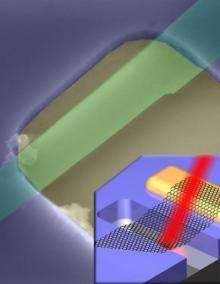Physics graduate creates graphene resonator

In the world of cutting-edge physics, discoveries are often made using intricate procedures and elaborate, expensive instruments. But a paper by Cornell graduate student Scott Bunch and colleagues shows how interesting results can also come from much simpler methods.
Bunch found that a single sheet of graphene, a form of carbon atoms in a plane just one atom thick, can be isolated and used as an electromechanical resonator. The material could be useful for weighing atoms and molecules, which have extremely small masses; as a membrane to separate gases or to measure pressure; or for other experiments that call for a very stiff but exceptionally thin and light sheet of material.
The research appears in the Jan. 26 issue of the journal Science.
Creating a sheet of cohesive material just one atom thick is impossible with most substances; most ball up or disintegrate as they are shaved into ever-thinner slices. Carbon, though, is unique: in diamonds, its covalent bonds form nature's hardest substance. And as graphite, it bonds tightly in a two-dimensional plane but very loosely in the third dimension. So sloughing off a few layers is as easy as writing with a pencil.
Bunch etched a silicon dioxide wafer with tiny trenches, each about 1 micron wide and 300 nanometers deep. He spread a light layer of graphite over the wafer simply by gluing a chunk of it onto a toothpick and writing on the wafer's surface. Using an optical microscope, he then identified trenches that were spanned by very thin layers (each tens of thousands of atoms across) of graphene sheets (the term for single-atom-thick sheets of graphite).
Using atomic force microscopy, which measures the amount of deflecting force a tiny cantilever experiences as it scans nanometers over the surface of a specimen, Bunch and colleagues determined the thickness of the layers (number of graphene sheets) that spanned the trenches. Raman spectroscopy, a technique that measures the way a substance scatters monochromatic light, confirmed that several trenches were spanned by single sheets of graphene. By delivering a tiny current to the single-atom bridges and using a laser to detect their vibrations, Bunch's group could determine the stiffness of the material.
"How fast they vibrate is a function of how thick they are, how long they are and how stiff the material itself is," Bunch said. "It turns out that graphene is one of the stiffest materials around."
It's also ultrathin and light, which might make it valuable as an extremely sensitive scale for tiny masses or a gauge for pressure differences.
And it's simple. "These are basically the thinnest vibrating structures you can have," said Bunch. "So it's surprising that they're so easy to make."
Source: Cornell University




















